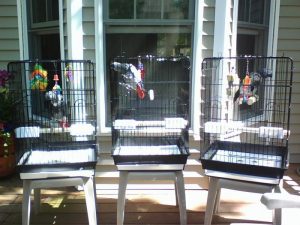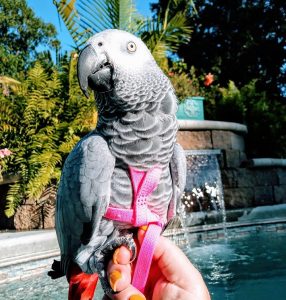
It’s is a beautiful day in the neighborhood. Your plans are to go outside to enjoy the day, take in the sunshine and feel slight breeze on your skin. You want to take your parrot out with you to get vitamin D and some fresh air. Afterall, they were not meant to be kept in an artificial indoor environment. Their health needs are much like ours; fresh air and sunshine included.
Sadly, this time of year we see so many ads for lost parrots. Some are escapees due to accidents , but others are caused by a lack of protection while being outside with owners. Many of these scenarios can be avoided by taking simple precautions and knowing your environment.
Safe Options to Enjoy the Great Outdoors
There are several options available for pet owners to explore. I have found the safest option is to have a smaller cage if your plans include staying outside for a longer period of time. Some cages are designed to collapse down for storage purposes. If you are using a collapsible cage, please be aware of the connections and the materials they are made from.
This storage feature also makes them more susceptible to falling apart when being lifted up or moving around. Be sure to check the security of the food dishes and doors. I suggest using small zip ties to attach the bottom plastic case to the cage itself as well as on the food doors in the event a cage is dropped for some reason, the cage parts will be held together. If you are using the cage option, make sure you place your bird in the cage INSIDE your residence. Do not open any cages outside for any reason.

Another option is a backpack type cases designed for parrots. I happen to own a few of them and they are fantastic for travel. However, not all are created equal. Make sure the product you are investing in is made from materials that is for the most part, chew resistant. Some carriers are made with a plastic mesh. It can be seconds before your parrot realizes this and they can chew their way out quickly. Others are made with Stainless Steel mesh and this is the protection you want. With that said, still inspect the carrier before each use to make sure a curious beak did not find a crevasse to work at and open up a hole.
Lately, I am seeing more carriers being made of acrylic. While this is the best option for known destructive beaks, be aware that they can get very hot inside with the sun and heat. I urge you if you have this type of product to make sure you have enough ventilation getting in the carrier and keep it out of direct sun. Some acrylic carriers offer an optional wire door that can be purchased as an add on. I highly suggest this option if you plan on using this type of carrier.
Stretch Your Wings with a Harness

There are several manufacturers of avian harnesses. Whichever one you choose, take the time to inspect the harness each time you put it on for any signs of weak spots due to a bird chewing while wearing it. Curious beaks can cause damage quickly. Purchase the correct size for your parrot according to weight. You want that product to perform correctly and it can only do so with proper placement and monitoring. Do not use any products that are made for raptors or tie anything to a bird’s band. This is a common practice oversea and some countries. Raptors leg structure is much different than psittacines. Raptor legs are stronger and designed to carry pray along with more muscle mass. Using an incorrect tether can break or damage a parrot’s leg.
Lost & Found
Do not be fooled with the false sense of security of clipping wings and thinking that will keep your bird safe outside. A bird with clipped wings can and will fly. There are many different factors that can come into play that can help carry your bird away. All parrots still have all their wild fight or flight instincts intact even though they live in our homes. If they are startled while outside, they will take flight. If they are caught in a wind stream or up sitting up on higher ground than surrounding property, they will get some height as well as distance and can get into a tree.
Being on social media I see several lost birds each day. If a bird is clipped it does not have the ability or agility to escape predators. It will not know where to find food or where to keep safe. It is our job as stewards to keep them safe, happy and healthy.
In my years I have personally assisted in retrieving several birds. I’ve been bitten by a dog and dredged through picker bush swampland. The time out trying to locate them or watching them while they flew from tree to tree was heartbreaking. While I had a 50/50 recovery rate, I still think of the ones that did not make it home.
People say to me time and time again that “my bird has been coming outside free for years”, “his wings are clipped”, “he’s never flown” or “he loves me too much to fly off”. Please do not think this. Your bird depends on you to know better and to protect them.
